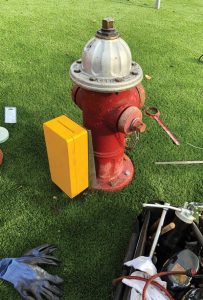For municipal workers, stopping watermain leaks can be a never-ending battle. Small leaks that are difficult to detect can quickly become big leaks. And, as municipalities know all too well, big leaks can take out a road.
Imagine, then, detecting a leak just as it starts?
A novel, game-changing technology developed by Digital Water Solutions (DWS) can do just that. The company has come up with a monitoring device that fits inside a standard fire hydrant, constantly listening for anything out of the ordinary in the water system to detect a watermain break before it gets worse.
A unit — about the size of a small shoebox — is also attached to the outside of the fire hydrant. The sensors inside the fire hydrant use sound technology to listen for abnormal patterns that may result in leaks. The sensors monitor the drinking water system, providing live data on temperature and pressure.
When noise levels of running water get significantly higher than the established baseline and consistently stay high, it indicates a leak. Cloud-based analytics track the data, sending automatic alerts to managers of any suspicious patterns.
“The whole point is that if you have an ongoing leak the noise level will stay high and you’ll hear it,” explains Tim Sutherns, head of automation and controls at DWS.
“We track baselines against previous historical data and what we’re basically looking for is significant changes in the pattern.
“It’s like pattern recognition. If you have an ongoing leak, you’ll hear it. By looking for pattern changes, we can identify something that’s not normal and, if that’s the case, then send out an alert to the municipality.”
The technology was tested recently by the City of Waterloo. Forty units were installed on hydrants in the city covering approximately 10 square kilometres. The units cost about $10,000 each. The city obtained funding from the Canadian Water and Wastewater Fund to implement the technology.
Each area was selected because of a history of leaks or breaks and the opportunity to test the units on different pipe materials.
The kit includes both the sensor and the electronics box which is attached to the outside of the fire hydrant. The electronics are on the outside so batteries can be changed easily and the modem can transmit information clearly. Inside, a stainless-steel ball goes on the lower valve assembly of the fire hydrant.
Sutherns says the technology is unique because it senses the pressure below the valve of the fire hydrant so there are no issues with freezing and therefore it allows the hydrants to remain in service year-round.

The sensors constantly collect water column pressure readings — up to 100 times a second to be exact — and do acoustic sampling at 4,000 times a second.
According to a report by Waterloo staff, the results of the test were a success, as the kits enabled the city to monitor pressure, transient pressure, acoustics or leak detection, and water temperature to gain greater visibility into the water distribution system and a deeper understanding of one of the city’s largest unseen assets.
“Typically, you don’t get to see those assets until there’s water flowing down your streets and residents calling in saying, ‘What just happened?’ ” says Sutherns.
The city notes the installed sensors enabled the municipality to identify four events in the system, confirming the validity of the instrumentation and the value of the units.
In two of the events, the sensors detected watermain breaks. One was detected by acoustic sensors during overnight monitoring periods within the area where the units were installed while the other detected a leak that resulted from a pipe being ruptured by a backhoe about six kilometres from the hydrants outfitted with sensors.
The sensors also picked up anomalies when an elevated tank was taken out of service and the instrumentation in the city’s system immediately recorded a change in the distribution system pressure.
A fourth event demonstrated the sensitivity of the devices. A small leak was detected using the acoustic data within an area monitored overnight by the units and an investigation discovered the event was an individual filling his swimming pool using a garden hose at a flow rate of up to 25 litres per minute.
“What they’ve found is that the data they’ve been receiving has been valuable and they’re able to see what’s happening in their system,” says Sutherns.
“They’re able to see everything from their pumps and valves and what’s going on and closing, and they’re able to see when a leak occurs, and they can pick up watermain breaks. It has been successful in terms of what they were hoping to achieve which is huge.”
The technology has also been installed in Guelph, Chatham-Kent and Wellington, as well as the United States and Iceland. DWS also has purchase orders from two more municipalities and is meeting with others.
The kits can be uninstalled and reinstalled in less than two hours.
For the test in Waterloo, kits were installed on every hydrant in a pre-determined area. Based on the success of the first test, the city now plans to widen the coverage area and space them every three to five hydrants.
The city has recently approved an automated water metre reading system so every house will soon be providing data which will provide even more help with watermain leak detection.



Recent Comments